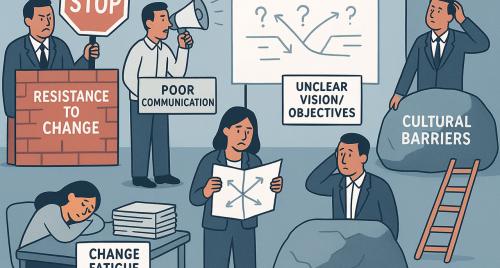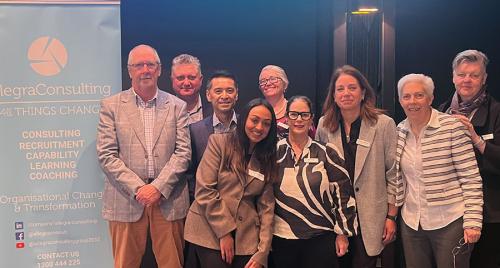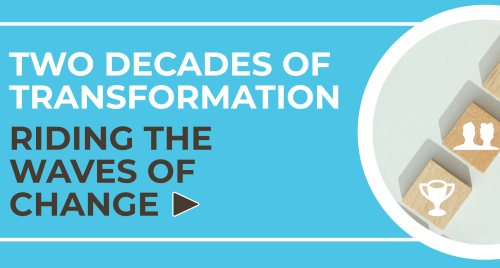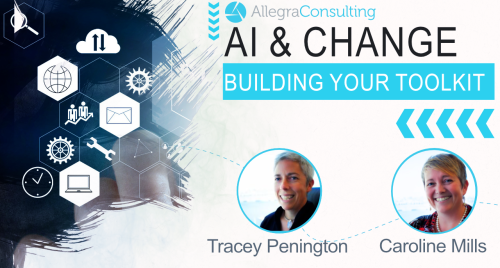
Some time back, I was walking past a café when I overheard a frustrated parent shout to their partner, “It’s your baby!” The child was in the midst of a meltdown in a pram, and in that moment, the ownership of the situation was being strongly and emotionally reassigned!
It made me chuckle at the time and feel some empathy for them both. But lately, that phrase keeps coming to mind when I think about change management in organisations.
For so long, change practitioners—myself included—have been the ones holding the baby. We’ve rocked it, soothed it, and cleaned up after it. We’ve written the change plans, done the comms, nudged the stakeholders, tried to shepherd the business through every emotion, roadblock, and implementation milestone, and yes, at times been at the blunt end of things going wrong (doesn’t it all become about people and change in the end!)
But here’s the thing: we’ve hit a tipping point.
The Volume of Change Is Too High
There’s simply too much change in most organisations for the change team (if they even have one!) to own it all. There aren't enough hours in the day—or people on the team—for change professionals to carry every program, every project, and every shift in ways of working. We are well and truly outnumbered.
And frankly, budgets are tighter than ever. Even when organisations recognise the value in good change practice, they often lack the resources to appoint a dedicated change lead for every initiative.
So, What’s the Alternative?
We move from owning the change… to facilitating it.
This isn’t about walking away. It’s about leaning into our role as enablers, coaches, designers of frameworks and support systems that allow the business to lead and own its own change. It’s a mindset shift, and it’s one that’s overdue.
Who Really Owns the Change?
Getting really clear on roles is where it starts.
Who's the sponsor of the change? What’s their role—and are they aware of it
Who are the product or business owners of the future state solution?
Are they across the risks, the process, and the behavioural shifts needed?
Because the truth is: the change doesn’t belong to us. It belongs to the people who will live with the results every day.
We bring professional expertise to guide the how—how to assess impacts, how to prepare people, how to support adoption—but we must work with the business from the beginning to define what success looks like.
Let’s Talk Success
Success measures are not just for reports. They’re the foundation of ownership.
If the business helps define them—if the sponsor, leaders and product owners are aligned on what a successful implementation looks like—then we’re in a much stronger position to say: “Great, now let’s work backwards and figure out how we get there together.”
These success measures should show up in governance forums. They should be reviewed, challenged, and taken ownership of. Because that’s where change sticks—or doesn’t.
Implementation readiness checklists aren’t just for ticking boxes—they’re for setting up accountability. If the business owns the success measures, then implementation readiness becomes their mirror: Are we ready to adopt this? Is our team prepared? Have we done the work?
Governance Isn’t Just a Meeting
Good governance is about ensuring that change is visible and cannot be overlooked. It’s about embedding the conversation into decision-making structures.
That might mean standing items in the Steering Committees on adoption and engagement. It might mean implementation readiness gates that the business has to step through, not the change manager. It definitely means asking, at every stage: “Who’s owning this?” and “Are they set up to succeed?”
Champions: The Secret Sauce
Change champions are another lever here. Done well, they’re not just cheerleaders—they’re the bridge between strategy and frontline reality. They give feedback, spread knowledge, build confidence, and normalise new behaviours.
However, they work best when the business sponsors them, supports them, and allocates time and space for them to lead. They help build change capability, not just communications.
Facilitating Doesn’t Mean Disappearing
Now—before anyone misreads this shift as change teams quietly slipping out the side door—let’s be crystal clear: facilitating change is not abdicating the work.
Yes, the business owns the change. Yes, our role is to enable, support, and build capability. But that doesn’t mean stepping so far back that no one knows what’s going on.
I’ve seen this happen—perhaps you've too.
A well-meaning change team starts talking about “facilitation” and “empowering the business,” but when you zoom in… there’s an abyss. No one is conducting the impact assessment. No comms is being written. There’s no change plan. The business has no idea what good looks like because we haven’t shown them.
We must stay clear-eyed on two things:
1. What is the actual change work required in this context?
2. Who is responsible for delivering that work?
It might still be us doing the change planning, the impact analysis, and the readiness work—but we’re doing it with transparency, shared ownership, and the goal of transferring knowledge where possible. In other cases, we may be coaching leaders or business owners to do that work themselves—with our guidance, templates, and support.
The danger is in assuming “the business owns the change” means we no longer need to get our hands dirty.
That’s not facilitation. That’s abandonment.
And it’s a surefire way to erode trust in what change practice can deliver.
So, by all means, step back from ownership. But never step away from clarity. Clarity on the work. Clarity on the roles. Clarity on the support that’s needed.
So, What’s the Real Shift Here?
Change managers need to let go of the idea that the change is our baby. It’s not. We’re not the parent—we’re the paediatrician. We monitor the health of the change, assist with developmental milestones, and offer guidance when things aren’t going as planned, but we don’t take the baby home. That’s the business’s job. They raise it, nurture it, and live with the results every day.
It’s time to build capacity, not dependency. Time to focus on embedding governance, role clarity, and capability that lives on well after we’ve left the room.
Because if the business doesn’t own the change, it’s just a project that happened to them. And we all know how that ends.












